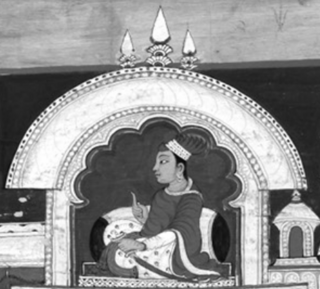Related Research Articles

The First Anglo-Burmese War, also known as the First Burma War, was the first of three wars fought between the British and Burmese empires in the 19th century. The war, which began primarily over the control of what is now Northeastern India, ended in a decisive British victory, giving the British total control of Assam, Manipur, Cachar and Jaintia as well as Arakan Province and Tenasserim. The Burmese submitted to a British demand to pay an indemnity of one million pounds sterling, and signed a commercial treaty.

Northeast India, officially known as the North Eastern Region(NER) is the easternmost region of India representing both a geographic and political administrative division of the country. It comprises eight states—Arunachal Pradesh, Assam, Manipur, Meghalaya, Mizoram, Nagaland and Tripura (commonly known as the "Seven Sisters"), and the "brother" state of Sikkim.

The Insurgency in Northeast India involves multiple separatist militant groups operating in some of India's northeastern states, which are connected to the rest of India by the Siliguri Corridor, a strip of land as narrow as 14.29 miles (23.00 km) wide.
The Hmar language or Khawsak ṭawng belongs to the Kukish branch of the Sino-Tibetan family of languages. The speakers of this language use Meitei language as their second language (L2).

The provinces of India, earlier presidencies of British India and still earlier, presidency towns, were the administrative divisions of British governance on the Indian subcontinent. Collectively, they have been called British India. In one form or another, they existed between 1612 and 1947, conventionally divided into three historical periods:

The history of Assam is the history of a confluence of people from the east, west, south and the north; the confluence of the Austroasiatic, Tibeto-Burman (Sino-Tibetan), Tai and Indo-Aryan cultures. Although invaded over the centuries, it was never a vassal or a colony to an external power until the third Burmese invasion in 1821, and, subsequently, the British ingress into Assam in 1824 during the First Anglo-Burmese War.
There were three Burmese invasions of Assam between 1817 and 1826, during which time the Kingdom of Assam came under the control of Burma from 1821 to 1825. Locally, this period, called the manor din by the Indigenous Assamese people is remembered with horror. The sharp drop in population due both to depredations as well emigrations left the erstwhile kingdom in shambles. It was the climactic period of the Ahom kingdom. The British, who were earlier reluctant to colonise Assam, came into direct contact with a belligerent Burmese occupying force. Following the First Anglo-Burmese War they annexed Assam and took Manipur as a subsidiary state.

Bagyidaw was the seventh king of the Konbaung dynasty of Burma from 1819 until his abdication in 1837. Prince of Sagaing, as he was commonly known in his day, was selected as crown prince by his grandfather King Bodawpaya in 1808, and became king in 1819 after Bodawpaya's death. Bagyidaw moved the capital from Amarapura back to Ava in 1823.

General Maha Bandula was commander-in-chief of the Royal Burmese Armed Forces from 1821 until his death in 1825 in the First Anglo-Burmese War. Bandula was a key figure in the Konbaung dynasty's policy of expansionism in Manipur and Assam that ultimately resulted in the war and the beginning of the downfall of the dynasty. Nonetheless, the general, who died in action, is celebrated as a national hero by the Burmese for his resistance to the British. Today, some of the most prominent places in the country are named after him.

Bodawpaya was the sixth king of the Konbaung dynasty of Burma. Born Maung Shwe Waing and later Badon Min, he was the fourth son of Alaungpaya, founder of the dynasty and the Third Burmese Empire. He was proclaimed king after deposing his nephew Phaungkaza Maung Maung, son of his eldest brother Naungdawgyi, at Ava. Bodawpaya moved the royal capital back to Amarapura in 1782. He was titled Hsinbyumyashin, not to be confused with his older brother Hsinbyushin. However, he became known to posterity as Bodawpaya (Grandsire) in relation to his successor, his grandson Bagyidaw, who in turn was given this name in relation to his nephew Mindon Min. He fathered 70 sons and 67 daughters by about 54 consorts.
The Ministry of Development of North Eastern Region is a Government of India ministry, established in September 2001, which functions as the nodal Department of the Central Government to deal with matters related to the socio-economic development of the eight States of Northeast India: Arunachal Pradesh, Assam, Manipur, Meghalaya, Mizoram, Nagaland, Tripura and Sikkim. It acts as a facilitator between the Central Ministries/ Departments and the State Governments of the North Eastern Region in the economic development including removal of infrastructural bottlenecks, provision of basic minimum services, creating an environment for private investment and to remove impediments to lasting peace and security in the North Eastern Region.

The red serow, also called the Burmese red serow is a goat-antelope thought to be native to southern Bangladesh and northern Myanmar. It has been sometimes been considered a subspecies of C. sumatraensis. In the northeastern part of India, the red serow occurs widely in the hills south of the Brahmaputra river. although the IUCN states that this species is recorded with certainty only from Myanmar, in Kachin State, and that records in India refer to the Himalayan serow.Serow in South and Southeast Asia are threatened by habitat destruction, poaching, and disease transmission from domestic livestock. Myanmar and India face severe poaching issues despite legal protections.

Sudingphaa also, Chandrakanta Singha, was a Tungkhungia king of the Ahom dynasty, who ruled at the climactic of the Ahom kingdom. His reign witnessed the invasion of Burmese on Assam and its subsequent occupation by British East India Company. He was installed as King twice. His first reign ended when Ruchinath Burhagohain deposed him and installed Purandar Singha in his stead. His second reign ended with his defeat at the hands of the invading Burmese army. He continued his militant efforts to regain his kingdom as well as to keep Purandar Singha at bay. Finally he submitted himself to Burmese who induced him to believe that they will make him king. Instead he was seized and placed in confinement at Rangpur. After the defeat of Burmese in the First Anglo-Burmese War and subsequent peace Treaty of Yandabo on 24 February 1826 CE, Assam passed into the hand of British. Most of the members of Ahom Royal family were granted pensions. Chandrakanta Singha received a pension of 500 rupees. He first lived in Kaliabor and later on at Guwahati. He visited Calcutta in order to request the restoration of his kingdom but in vain. He died in 1839 CE soon after his return to Guwahati.

Christianity is the third largest religion in Assam. Assam is a state in the north-eastern region of India. The total population of Christians in the state of Assam is 1,165,867, which, according to the 2011 census comprises 3.74% of the state's total population. After Islam, Christianity is also the second-fastest growing religion of Assam. The largest concentration of Christians in Assam can be found in the Dima Hasao District where the Christian population numbers as approximately 30% of the whole. The second largest concentration of Christians in Assam is in the Karbi Anglong district where the Christian population is approximately 16.5% of the whole.

Orunodoi or Arunodoi was the first Assamese-language magazine published monthly from Sibsagar, Assam, in 1846. The magazine created a new era in the world of Assamese literature and gave birth to notable authors such as Anandaram Dhekial Phukan, Hemchandra Barua, Gunabhiram Barua, and Nidhi Levi Farwell. The magazine took the initiative of innovating the then Assamese dialect instead of borrowing words from other languages. The Assamese people got to know about the western world only through this magazine, which opened the gate to the modern literacy in Assam. It mainly included various news related to current affairs, Science, astrology, history and also trivia although Christianity was its main aim. The magazine's publishing ended when the printing press was sold in 1883.

Purandar Singha was the last king of the Ahom kingdom in Assam. He was installed as king twice. The first time, he was installed by Ruchinath Burhagohain in 1818 CE, after the latter deposed Chandrakanta Singha from the throne. His first reign ended in 1819 CE, during the second Burmese invasion of Assam, when his forces were defeated and the Burmese reinstalled Chandrakanta Singha on the throne. He along with Ruchinath Burhagohain continued their efforts to expel Burmese invaders, by seeking help from British and through armed struggle. After First Anglo-Burmese War, the British East India Company took over Assam from the Burmese invaders. Finding it difficult to administer an unfamiliar region and sensing discontent among the local inhabitants to foreign rule, the British authorities decided to restore Upper Assam to a prince of Ahom Dynasty. Purander Singha was found suitable for this post and therefore, in April 1833 CE, except for Sadiya and Matak rajya, the entire territory of Upper Assam was formally made over to him, on the condition of yearly tribute of 50,000 rupees. Later, in 1838 CE, finding him incompetent and a defaulter in payments of revenue, the British formally annexed his kingdom, putting an end to a 600 years reign of the Ahom dynasty. When Purandar Singha accepted the position of prince over upper Assam, he did not realize the difficulties of his new position.

Jogeswar Singha was installed as the king of Ahom kingdom in 1821 CE, by the Burmese. He was more or less a puppet in the hands of the Burmese, who held the real power of administration. His reign witnessed Burmese atrocities on the people of Assam and the attempts made by Chandrakanta Singha and Purandar Singha to expel Burmese invaders. Historians dispute regarding the date of his deposition from the throne, as some historians claimed that he was deposed by his Burmese masters, after they secured complete victory over the forces of Chandrakanta Singha in 1822 CE, while some sources claimed that he remained as a puppet ruler till termination of Burmese rule in Assam by British East India Company, in 1825 CE, during First Anglo-Burmese War.
Jorhat is one of the important cities and a growing urban centre in the state of Assam in India.

The Manipur Kingdom was an ancient kingdom at the India–Burma frontier that became a protectorate of the British East India Company from 1824, and a princely state of British Raj in 1891. It bordered Assam Province in the west and British Burma in the east, and in the 20th century covered an area of 22,327 square kilometres and contained 467 villages. The capital of the state was Imphal.
References
- ↑ "HistoryOfAssam – Assam Online Portal". Online.assam.gov.in. Archived from the original on 17 August 2012. Retrieved 4 May 2013.